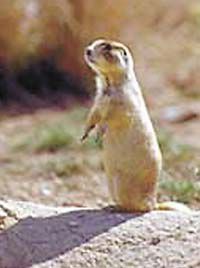| White-tailed prairie dogs are the species that exist in Carbon County. |
A program to count prairie dog populations will soon be launched in eastern Utah.
According to Utah State University Eztension conservation specialixt Sarah Lupis, the count will soon be underway throughout the state.
“Actually, the count is part of an entire plan in which Utah State Extension and the division of wildlife resources are partnering,” explained Lupis at the Carbon County Commission meeting on Oct. 3. “The plan is being enacted so that the prairie dog will be precluded from the endangered species list.”
Prarie dogs are rodents within the squirrel family.
Utah boasts three kinds of the prairie dogs. The species include the Utah prairie dog, Cynomys parvidens, found in the southwestern part of the state; the white-tailed prairie dog, Cynomys leucurus, common to the eastern part of the state; and the Gunnison prairie dog, Cynomys gunnisoni, present only in the San Juan County area.
The Utah prairie dog is currently listed under the Endangered Species Act as threatened.
“The prairie dog is one of those animals that is considered a dual species,” said Lupis. “In other words, by some it is considered a pest, while by others it is considered sensitive. It is also what we call a keystone species; one that is key to grasslands and does things that support other kinds of animals.”
Designated as an endangered species in 1973, the Utah prairie dog was down-listed to a threatened species in 1984
The federal designations have created a controversy in the Cedar City area during the years.
Before the mid-1970s, the animals were considered a pest, destroying a lot of farmers crops in the Cedar City area. At that time, poisoning and other forms of killing were used to destroy the prarie dogs.
The animal’s numbers have come up enough that the prarie dogs are currently considered threatened rather than endangered.
The white-tailed prairie dog numbers remain a bit of a mystery, however. The mystery is the reason for the count.
Lupis told the Carbon County commissioners that there are four threats to prairie dogs in the state.
First, between 50 and 75 years ago, a flea began to infect the animals with the plague.
“That was devastating to their populations,” she said. “And that plague could be a danger to humans too.”
The second threat involves the control methods that human beings have been using to eradicate the prairie dogs from places like farms, school grounds and other areas.
The third threat has resulted from the decline in populations created by land conversion – from rural to urban from agriculture or wild to paved parking and streets at locations across the state.
Finally a lot of prairie dogs have been eradicated by people shooting them.
Lupis told the commission that for the next year the DWR will be doing a count on the animals.
“They obviously can’t count each and every one of the individuals, but the can estimate their numbers based on the colonies they observe,” she said. “That will give us a baseline with which to work.”
Keeping the animals off the endangered species list is a goal many public agencies strive to attain. Once an animal is included on the list, the designation creates significant roadblocks for development and activities not only on federal land, but also on state and private properties.
Some critics of the federal act claim that the regulation violates the United States Constitution by keeping people from exercising private property rights.

